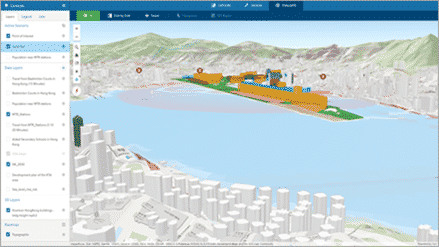Create, Analyze, and Report on Planning Scenarios
Design, test and collaborate on scenarios in 2D and 3D.
ArcGIS GeoPlanner is an app for informed, evidence– and performance–based planning and design. It provides a design framework and supporting technology for professionals to leverage geographic information, resulting in designs that more closely follow natural systems. GeoPlanner is a collaborative tool—you can work simultaneously with others on plans and designs or share items including web maps, feature layers, and data exports. GeoPlanner supports a complete planning workflow from project creation to report generation. The workflow is implemented across different segments within the application. Geodesign concepts including immediate feedback, collaborative decision making, and assessing site performance and conditions influence all parts of the workflow. The following sections provide an overview of working with the application.

Explore
Discover, analyze, and model.
GeoPlanner allows you to discover shared GIS datasets on ArcGIS Online and add them to your project. You can also use your data or access Esri-provided content, including landscape data. You can assess site suitability and conditions using weighted raster overlay, spatial analytics, GeoEnrichment, and layer classification. You can use assessments in dashboards to help understand how your designs interact with a site.
Design
Plan and test with real–time dashboards.
GeoPlanner allows you to sketch in multiple alternative design scenarios. As you sketch, dashboards help you visualize suitability and probable impacts by comparing your designs to assessments. You can also import features into a scenario to help you understand existing conditions. Scenarios are shared with everyone in a project so your team has access to all designs.


Evaluate
GeoPlanner has comparison and evaluation tools to help you visualize your design’s impact. You can compare scenarios side–by–side to see how alternative planning scenarios and their impacts differ. In this mode, you have access to dashboards so you can understand qualitative and quantitative differences. A Key Performance Indicator report allows you to view all indicators across one or more scenarios.
Collaborate
GeoPlanner helps you share data and collaborate with your stakeholders. This helps you validate your design decisions with others. You can share data, projects, dashboards, web maps and more. Nearly everything you create in GeoPlanner can be used across the ArcGIS Platform.

Create, Analyze, and Report on Planning Scenarios
Design, test and collaborate on scenarios in 2D and 3D.
ArcGIS GeoPlanner is an app for informed, evidence– and performance–based planning and design. It provides a design framework and supporting technology for professionals to leverage geographic information, resulting in designs that more closely follow natural systems. GeoPlanner is a collaborative tool—you can work simultaneously with others on plans and designs or share items including web maps, feature layers, and data exports. GeoPlanner supports a complete planning workflow from project creation to report generation. The workflow is implemented across different segments within the application. Geodesign concepts including immediate feedback, collaborative decision making, and assessing site performance and conditions influence all parts of the workflow. The following sections provide an overview of working with the application.
Explore

Discover, analyze, and model.
GeoPlanner allows you to discover shared GIS datasets on ArcGIS Online and add them to your project. You can also use your data or access Esri-provided content, including landscape data. You can assess site suitability and conditions using weighted raster overlay, spatial analytics, GeoEnrichment, and layer classification. You can use assessments in dashboards to help understand how your designs interact with a site.
Design

Plan and test with real–time dashboards.
GeoPlanner allows you to sketch in multiple alternative design scenarios. As you sketch, dashboards help you visualize suitability and probable impacts by comparing your designs to assessments. You can also import features into a scenario to help you understand existing conditions. Scenarios are shared with everyone in a project so your team has access to all designs.
Evaluate

GeoPlanner has comparison and evaluation tools to help you visualize your design’s impact. You can compare scenarios side–by–side to see how alternative planning scenarios and their impacts differ. In this mode, you have access to dashboards so you can understand qualitative and quantitative differences. A Key Performance Indicator report allows you to view all indicators across one or more scenarios.
Collaborate

GeoPlanner helps you share data and collaborate with your stakeholders. This helps you validate your design decisions with others. You can share data, projects, dashboards, web maps and more. Nearly everything you create in GeoPlanner can be used across the ArcGIS Platform.
